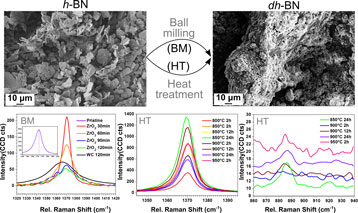Crossref Citations
This article has been cited by the following publications. This list is generated based on data provided by
Crossref.
Mussa, Yasmin
Ahmed, Faheem
Arsalan, Muhammad
and
Alsharaeh, Edreese
2020.
Two dimensional (2D) reduced graphene oxide (RGO)/hexagonal boron nitride (h-BN) based nanocomposites as anodes for high temperature rechargeable lithium-ion batteries.
Scientific Reports,
Vol. 10,
Issue. 1,
Ikram, M.
Hussain, I.
Hassan, J.
Haider, A.
Imran, M.
Aqeel, M.
Ul-Hamid, A.
and
Ali, S.
2020.
Evaluation of antibacterial and catalytic potential of copper-doped chemically exfoliated boron nitride nanosheets.
Ceramics International,
Vol. 46,
Issue. 13,
p.
21073.
Raza, A.
Qumar, U.
Hassan, J.
Ikram, M.
Ul-Hamid, A.
Haider, J.
Imran, M.
and
Ali, S.
2020.
A comparative study of dirac 2D materials, TMDCs and 2D insulators with regard to their structures and photocatalytic/sonophotocatalytic behavior.
Applied Nanoscience,
Vol. 10,
Issue. 10,
p.
3875.
Hassan, J.
Ikram, M.
Ul-Hamid, A.
Imran, M.
Aqeel, M.
and
Ali, S.
2020.
Application of Chemically Exfoliated Boron Nitride Nanosheets Doped with Co to Remove Organic Pollutants Rapidly from Textile Water.
Nanoscale Research Letters,
Vol. 15,
Issue. 1,
Ikram, M.
Hassan, J.
Imran, M.
Haider, J.
Ul-Hamid, A.
Shahzadi, I.
Ikram, M.
Raza, A.
Qumar, U.
and
Ali, S.
2020.
2D chemically exfoliated hexagonal boron nitride (hBN) nanosheets doped with Ni: synthesis, properties and catalytic application for the treatment of industrial wastewater.
Applied Nanoscience,
Vol. 10,
Issue. 9,
p.
3525.
Ikram, M.
Jahan, I.
Haider, A.
Hassan, J.
Ul-Hamid, A.
Imran, M.
Haider, J.
Shahzadi, A.
Shahbaz, A.
and
Ali, S.
2020.
Bactericidal behavior of chemically exfoliated boron nitride nanosheets doped with zirconium.
Applied Nanoscience,
Vol. 10,
Issue. 7,
p.
2339.
Duan, Lijie
Wang, Bo
Heck, Kimberly
Guo, Sujin
Clark, Chelsea A.
Arredondo, Jacob
Wang, Minghao
Senftle, Thomas P.
Westerhoff, Paul
Wen, Xianghua
Song, Yonghui
and
Wong, Michael S.
2020.
Efficient Photocatalytic PFOA Degradation over Boron Nitride.
Environmental Science & Technology Letters,
Vol. 7,
Issue. 8,
p.
613.
Injongkol, Yuwanda
Intayot, Ratchadaree
Yodsin, Nuttapon
Montoya, Alejandro
and
Jungsuttiwong, Siriporn
2021.
Mechanistic insight into catalytic carbon dioxide hydrogenation to formic acid over Pt-doped boron nitride nanosheets.
Molecular Catalysis,
Vol. 510,
Issue. ,
p.
111675.
Si, Chaowei
Lian, Zan
Yang, Min
and
Li, Bo
2021.
Probing the reaction mechanism of acetylene hydrochlorination on metal-free doped boron nitride: Decisive role of carbon dopant.
Applied Surface Science,
Vol. 566,
Issue. ,
p.
150710.
Molaei, Mohammad Jafar
Younas, Mohammad
and
Rezakazemi, Mashallah
2021.
A Comprehensive Review on Recent Advances in Two-Dimensional (2D) Hexagonal Boron Nitride.
ACS Applied Electronic Materials,
Vol. 3,
Issue. 12,
p.
5165.
Hassan, Jahanzeb
Naz, Sadia
Haider, Ali
Raza, Ali
Ul-Hamid, Anwar
Qumar, Usman
Haider, Junaid
Goumri-Said, Souraya
Kanoun, Mohammed Benali
and
Ikram, Muhammad
2021.
h-BN nanosheets doped with transition metals for environmental remediation; a DFT approach and molecular docking analysis.
Materials Science and Engineering: B,
Vol. 272,
Issue. ,
p.
115365.
Raza, A.
Hassan, J.Z.
Ikram, M.
Naz, S.
Haider, A.
Ul-Hamid, A.
Shahzadi, I.
Haider, J.
Goumri-Said, S.
Kanoun, M.B.
and
Ali, S.
2021.
Molecular docking and DFT analyses of magnetic cobalt doped MoS2 and BN nanocomposites for catalytic and antimicrobial explorations.
Surfaces and Interfaces,
Vol. 27,
Issue. ,
p.
101571.
Ikram, Muhammad
Wakeel, Muhammad
Hassan, Jahanzeb
Haider, Ali
Naz, Sadia
Ul-Hamid, Anwar
Haider, Junaid
Ali, Salamat
Goumri-Said, Souraya
and
Kanoun, Mohammed Benali
2021.
Impact of Bi Doping into Boron Nitride Nanosheets on Electronic and Optical Properties Using Theoretical Calculations and Experiments.
Nanoscale Research Letters,
Vol. 16,
Issue. 1,
Payne, Anthony J. R.
Xavier, Neubi F.
Bauerfeldt, Glauco F.
and
Sacchi, Marco
2022.
Dehydrogenation of ammonia on free-standing and epitaxial hexagonal boron nitride.
Physical Chemistry Chemical Physics,
Vol. 24,
Issue. 34,
p.
20426.
Kovalskii, Andrey M.
Volkov, Ilia N.
Evdokimenko, Nikolay D.
Tkachenko, Olga P.
Leybo, Denis V.
Chepkasov, Ilya V.
Popov, Zakhar I.
Matveev, Andrei T.
Manakhov, Anton
Permyakova, Elizaveta S.
Konopatsky, Anton S.
Kustov, Alexander L.
Golberg, Dmitri V.
and
Shtansky, Dmitry V.
2022.
Hexagonal BN- and BNO-supported Au and Pt nanocatalysts in carbon monoxide oxidation and carbon dioxide hydrogenation reactions.
Applied Catalysis B: Environmental,
Vol. 303,
Issue. ,
p.
120891.
Yu, Sheng
Neupane, Tikaram
Tabibi, Bagher
Li, Qiliang
and
Seo, Felix
2022.
Spin-Resolved Visible Optical Spectra and Electronic Characteristics of Defect-Mediated Hexagonal Boron Nitride Monolayer.
Crystals,
Vol. 12,
Issue. 7,
p.
906.
Chen, Yu
Bhati, Manav
Walls, Benjamin W.
Wang, Bo
Wong, Michael S.
and
Senftle, Thomas P.
2022.
Mechanistic Insight into the Photo-Oxidation of Perfluorocarboxylic Acid over Boron Nitride.
Environmental Science & Technology,
Vol. 56,
Issue. 12,
p.
8942.
Liu, Yuwei
Liu, Hongyang
Luo, Lukai
Lin, Baining
Zhou, Yonghua
Wang, Hanqing
Wang, Ping
and
Mao, Yu
2023.
Improved Catalytic Performance of Direct Dehydrogenation of Ethylbenzene by Creating Boron Defects on Phosphorus‐doped Boron Nitride.
ChemCatChem,
Vol. 15,
Issue. 4,
Konopatsky, Anton S.
Leybo, Denis V.
Kalinina, Vladislava V.
Zilberberg, Igor L.
Antipina, Liubov Yu.
Sorokin, Pavel B.
and
Shtansky, Dmitry V.
2023.
Synergistic Catalytic Effect of Ag and MgO Nanoparticles Supported on Defective BN Surface in CO Oxidation Reaction.
Materials,
Vol. 16,
Issue. 2,
p.
470.
Torres-Davila, Fernand E.
Chagoya, Katerina L.
Blanco, Emma E.
Shahzad, Saqib
Shultz-Johnson, Lorianne R.
Mogensen, Mirra
Gesquiere, Andre
Jurca, Titel
Rochdi, Nabil
Blair, Richard G.
and
Tetard, Laurene
2024.
Room temperature 3D carbon microprinting.
Nature Communications,
Vol. 15,
Issue. 1,
